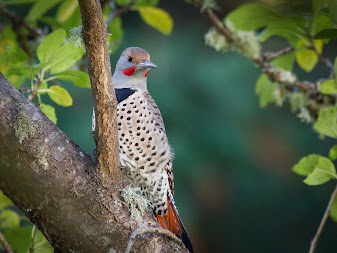For the Birds: Fall Is a Time of Change for Birds
Tuesday, October 4, 2022
Gone are the Osprey and the warblers; incoming are the Snow Geese and other wintering birds.
Early last week our neighborhood was filled with the sounds of several different species arriving from the north to stay for their winter season.
Incoming Dark-eyed Juncos and American Robins were both heard in numbers.
Leave a patch of flower heads for the juncos and sparrows which prefer seeds and keep some of your leaves on the ground where bug-eaters like towhees, Fox Sparrows, and wrens can find the bug meals they need.
Another helpful action that you can do to save birds—dim outside lights.
And something else to look forward to:
Resident chickadees, Spotted Towhees, and Song Sparrows, even Red-breasted Nuthatches and Northern Flickers greeted these seasonal residents with a mix of contact calls.
The robins we see in the summer have mostly flown further south, replaced by these northern birds.
 |
| Fox Sparrow use leaves to uncover bugs. Preferred winter shelter is a blackberry thicket. Photo by Craig Kerns |
Many of the juncos we see in the winter also flew from the boreal forests in Canada to enjoy our milder winters, adding to our resident junco population.
In eastern parts of the US, juncos are called “Snow Birds” because they are only present in the wintertime there.
There’s a noticeable change in bird sounds; our year-round birds have switched from territorial songs to mostly contact, “Here I am” calls.
There’s a noticeable change in bird sounds; our year-round birds have switched from territorial songs to mostly contact, “Here I am” calls.
Our resident Bewick’s Wrens are still
You can help our wintering birds by providing food, water, and shelter.
You can help our wintering birds by providing food, water, and shelter.
Save leaves and seed heads. Keep a thickness of leaves somewhere in your yard. These can still be neat (or not), but they do make a difference.
 |
| Dark-eyed Junco drinking water, a vital commodity. Photo by Craig Kerns |
Fresh water is always needed and will draw many birds.
Shelter, like varying heights of shrubs, bushes, and trees help protect from inclement weather, and offer escape routes from predators.
A small brush pile is a welcome retreat, and even a small patch of blackberries offers perfect winter protection.
 |
| Red-shafted Northern Flicker, male, using much needed tree for shelter and nesting. Photo by Craig Kerns |
Birds mostly migrate at night for safety from predators, and bright lights often confuse them, causing them to fly into windows, circle large towers of lights, and generally get exhausted and die.
Smaller wattage, non-bright white, and lighting pointing downward helps.
And something else to look forward to:
Snow Geese should arrive from Wrangel Island, Russia, to the Skagit farm area in late October. Add some Tundra Swans.





1 comments:
Wow! So much fascinating and helpful info here about our neighborhood birds! Thank you, Chris!
Post a Comment